Equation of State for Bismuth at High Energy Densities
Abstract
:1. Introduction
2. EOS Model
3. Thermodynamic Properties of Bismuth
4. Conclusions
Funding
Institutional Review Board Statement
Informed Consent Statement
Data Availability Statement
Conflicts of Interest
References
- Zel’dovich, Y.B.; Raizer, Y.P. Physics of Shock Waves and High-Temperature Hydrodynamic Phenomena; Academic Press: New York, NY, USA, 1967. [Google Scholar]
- Bushman, A.V.; Fortov, V.E.; Kanel’, G.I.; Ni, A.L. Intense Dynamic Loading of Condensed Matter; Taylor & Francis: Washington, DC, USA, 1993. [Google Scholar]
- Fortov, V.E. Extreme States of Matter: High Energy Density Physics, 2nd ed.; Springer Series in Materials Science; Springer: Berlin/Heidelberg, Germany, 2016; Volume 216. [Google Scholar]
- Aleksandrov, V.V.; Branitskii, A.V.; Grabovski, E.V.; Laukhin, Y.N.; Oleinik, G.M.; Tkachenko, S.I.; Frolov, I.N.; Khishchenko, K.V. Study of the impact of a duralumin flyer with a tungsten target at the Angara-5-1 facility. Plasma Phys. Rep. 2019, 45, 421–426. [Google Scholar] [CrossRef]
- Kraus, E.I.; Fomin, V.M.; Shabalin, I.I. Construction of a unified curve in modeling the process of crater formation by compact projectiles of different shapes. J. Appl. Mech. Tech. Phys. 2020, 61, 855–865. [Google Scholar] [CrossRef]
- Rodionov, E.S.; Lupanov, V.G.; Gracheva, N.A.; Mayer, P.N.; Mayer, A.E. Taylor impact tests with copper cylinders: Experiments, microstructural analysis and 3D SPH modeling with dislocation plasticity and MD-informed artificial neural network as equation of state. Metals 2022, 12, 264. [Google Scholar] [CrossRef]
- Lapushkina, T. Principles of magnetohydrodynamical control of internal and external supersonic flows. Energies 2022, 15, 5641. [Google Scholar] [CrossRef]
- Ashitkov, S.I.; Komarov, P.S.; Struleva, E.V.; Agranat, M.B.; Kanel, G.I.; Khishchenko, K.V. The behavior of tantalum under ultrashort loads induced by femtosecond laser. J. Phys. Conf. Ser. 2015, 653, 012001. [Google Scholar] [CrossRef]
- Tan, S.; Wang, M.; Wu, J.; Zhang, Y.; Li, J. A study on the plasma plume expansion dynamics of nanosecond laser ablating Al/PTFE. Energies 2020, 13, 3321. [Google Scholar] [CrossRef]
- Semenov, A.Y.; Stuchebryukhov, I.A.; Khishchenko, K.V. Modeling of shock-wave processes in aluminum under the action of a short laser pulse. Math. Montis. 2021, 50, 108–118. [Google Scholar] [CrossRef]
- Khokhlov, V.A.; Zhakhovsky, V.V.; Inogamov, N.A.; Ashitkov, S.I.; Sitnikov, D.S.; Khishchenko, K.V.; Petrov, Y.V.; Manokhin, S.S.; Nelasov, I.V.; Shepelev, V.V.; et al. Melting of titanium by a shock wave generated by an intense femtosecond laser pulse. JETP Lett. 2022, 115, 523–530. [Google Scholar]
- Gnyusov, S.F.; Rotshtein, V.P.; Mayer, A.E.; Rostov, V.V.; Gunin, A.V.; Khishchenko, K.V.; Levashov, P.R. Simulation and experimental investigation of the spall fracture of 304L stainless steel irradiated by a nanosecond relativistic high-current electron beam. Int. J. Fract. 2016, 199, 59–70. [Google Scholar]
- Khishchenko, K.V.; Charakhch’yan, A.A. Reflection of detonation wave from the symmetry plane within a cylindrical target for controlled thermonuclear fusion. Comput. Math. Math. Phys. 2021, 61, 1682–1699. [Google Scholar] [CrossRef]
- Sadovnichii, D.N.; Milekhin, Y.M.; Kalinin, Y.G.; Kazakov, E.D.; Lavrov, G.S.; Sheremet’ev, K.Y. Impact of a relativistic electron beam on cast aluminized energetic condensed systems. Combust. Explos. Shock Waves 2022, 58, 206–216. [Google Scholar] [CrossRef]
- Kondratyev, A.M.; Korobenko, V.N.; Rakhel, A.D. Metal–non-metal transition in lead–bismuth eutectic. J. Phys. Condens. Matter 2022, 34, 195601. [Google Scholar] [CrossRef]
- Maler, D.; Efimov, S.; Liverts, M.; Theocharous, S.; Strucka, J.; Yao, Y.; Proud, W.; Rack, A.; Lukic, B.; Bland, S.N.; et al. Peculiarities of planar shockwave interaction with air–water interface and solid target. Phys. Plasmas 2022, 29, 063502. [Google Scholar] [CrossRef]
- Barengolts, S.A.; Uimanov, I.V.; Oreshkin, V.I.; Khishchenko, K.V.; Oreshkin, E.V. Effect of the temperature of an electrode microprotrusion on the microcrater formation on the electrode surface upon pulsed and radiofrequency vacuum breakdowns. Vacuum 2022, 204, 111364. [Google Scholar] [CrossRef]
- Lomonosov, I.V.; Fortova, S.V. Wide-range semiempirical equations of state of matter for numerical simulation on high-energy processes. High Temp. 2017, 55, 585–610. [Google Scholar] [CrossRef]
- Azarova, O.A.; Lapushkina, T.A.; Krasnobaev, K.V.; Kravchenko, O.V. Redistribution of energy during interaction of a shock wave with a temperature layered plasma region at hypersonic speeds. Aerospace 2021, 8, 326. [Google Scholar] [CrossRef]
- Mursenkova, I.V.; Ivanov, I.E.; Liao, Y.; Kryukov, I.A. Experimental and numerical investigation of a surface sliding discharge in a supersonic flow with an oblique shock wave. Energies 2022, 15, 2189. [Google Scholar] [CrossRef]
- Li, Y.; Shen, S.; Niu, C.; Guo, Y.; Zhang, L. The effect of different pressure conditions on shock waves in a supersonic steam ejector. Energies 2022, 15, 2903. [Google Scholar] [CrossRef]
- Cai, F.; Huang, G.; Liu, X. Investigation of shock wave oscillation suppression by overflow in the supersonic inlet. Energies 2022, 15, 3879. [Google Scholar] [CrossRef]
- Sokolova, T.S.; Dorogokupets, P.I. Equations of state of Ca-silicates and phase diagram of the CaSiO3 system under upper mantle conditions. Minerals 2021, 11, 322. [Google Scholar] [CrossRef]
- Liu, Y.; Zhang, X.; Bi, H.; Liu, X.; Wang, F. First-principles prediction of structure, mechanical and thermodynamic properties of BixGeyOz ternary bismuth crystals. Vacuum 2022, 195, 110696. [Google Scholar] [CrossRef]
- Li, Y.; Sun, S.; He, Y.; Li, H. First-principles calculations about elastic and Li+ transport properties of lithium superoxides under high pressure and high temperature. Chin. Phys. Lett. 2021, 39, 026101. [Google Scholar] [CrossRef]
- Sokolova, T.S.; Dorogokupets, P.I.; Filippova, A.I. Equations of state of clino- and orthoenstatite and phase relations in the MgSiO3 system at pressures up to 12 GPa and high temperatures. Phys. Chem. Miner. 2022, 49, 37. [Google Scholar] [CrossRef]
- Horsley, G.W. The preparation of bismuth for use in a liquid-metal fuelled reactor. J. Nucl. Energy 1957, 6, 41–52. [Google Scholar] [CrossRef]
- Bauer, G.S.; Salvatores, M.; Heusener, G. MEGAPIE, a 1 MW pilot experiment for a liquid metal spallation target. J. Nucl. Mater. 2001, 296, 17–33. [Google Scholar] [CrossRef]
- Borella, A.; Belgya, T.; Kopecky, S.; Gunsing, F.; Moxon, M.; Rejmund, M.; Schillebeeckx, P.; Szentmiklosi, L. Determination of the 209Bi(n,γ)210Bi and 209Bi(n,γ)210m,gBi reaction cross sections in a cold neutron beam. Nucl. Phys. A 2011, 850, 1–21. [Google Scholar] [CrossRef]
- Mueller, A.C. Transmutation of nuclear waste and the future MYRRHA demonstrator. J. Phys. Conf. Ser. 2013, 420, 012059. [Google Scholar] [CrossRef]
- Shor, A.; Weissman, L.; Tessler, M.; Aviv, O.; Eisen, Y.; Feinberg, G.; Mishnayot, Y.; Plompen, A.; Vaintraub, S. Measurements of the 210gBito 210mBi activation ratio for the 209Bi(n,γ) reaction with thermal and epithermal neutrons at the Soreq IRR1 reactor. Phys. Rev. C 2022, 105, 025802. [Google Scholar] [CrossRef]
- Johnson, J.N.; Hayes, D.B.; Asay, J.R. Equations of state and shock-induced transformations in solid I–solid II–liquid bismuth. J. Phys. Chem. Solids 1974, 35, 501–515. [Google Scholar] [CrossRef]
- Bushman, A.V.; Glushak, B.L.; Gryaznov, V.K.; Zhernokletov, M.V.; Krasyuk, I.K.; Pashinin, P.P.; Prokhorov, A.M.; Ternovoi, V.Y.; Filimonov, A.S.; Fortov, V.E. Shock compression and adiabatic decompression of a dense bismuth plasma at extreme thermal energy densities. JETP Lett. 1986, 44, 480–483. [Google Scholar]
- Lomonosov, I.V.; Fortov, V.E.; Khishchenko, K.V.; Levashov, P.R. Phase diagrams and thermodynamic properties of metals at high pressures, high temperatures. AIP Conf. Proc. 2002, 620, 111–114. [Google Scholar]
- Heuze, O. Building of equations of state with numerous phase transitions—Application to bismuth. AIP Conf. Proc. 2006, 845, 212–215. [Google Scholar]
- Kane, J.O.; Smith, R.F. Modeling non-equilibrium phase transitions in isentropically compressed Bi. AIP Conf. Proc. 2006, 845, 244–247. [Google Scholar]
- Cox, G.A. A multi-phase equation of state for bismuth. AIP Conf. Proc. 2007, 955, 151–154. [Google Scholar]
- Li, Y.H.; Chang, J.Z.; Li, X.M.; Yu, Y.Y.; Dai, C.D.; Zhang, L. Multiphase equation of states of solid and liquid phases for bismuth. Acta Phys. Sin. 2012, 61, 206203. [Google Scholar]
- Fortov, V.E.; Lomonosov, I.V. Ya B Zeldovich and equation of state problems for matter under extreme conditions. Phys. Usp. 2014, 57, 219–233. [Google Scholar] [CrossRef]
- Kinelovskii, S.A.; Maevskii, K.K. Modeling shock loading of multicomponent materials including bismuth. High Temp. 2016, 54, 675–681. [Google Scholar] [CrossRef]
- Su, C.; Liu, Y.; Wang, Z.; Song, W.; Asimow, P.D.; Tang, H.; Xie, H. Equation of state of liquid bismuth and its melting curve from ultrasonic investigation at high pressure. Phys. B 2017, 524, 154–162. [Google Scholar] [CrossRef]
- Kirzhnits, D.A. Quantum corrections to the Thomas–Fermi equation. Sov. Phys. JETP 1957, 5, 64–71. [Google Scholar]
- Kirzhnits, D.A. The limits of applicability of the quasi-classical equation of state of matter. Sov. Phys. JETP 1959, 8, 1081–1089. [Google Scholar]
- Kalitkin, N.N. The Thomas–Fermi model of the atom with quantum and exchange corrections. Sov. Phys. JETP 1960, 11, 1106–1110. [Google Scholar]
- Kalitkin, N.N.; Kuzmina, L.V. Tables of Thermodynamic Functions of Matter at High Concentration of Energy; Institute of Applied Mathematics of the Academy of Sciences USSR: Moscow, Russia, 1975. [Google Scholar]
- Khishchenko, K.V. The equation of state for magnesium at high pressures. Tech. Phys. Lett. 2004, 30, 829–831. [Google Scholar] [CrossRef]
- Lomonosov, I.V.; Fortov, V.E.; Khishchenko, K.V. Model of wide-range equations of polymer materials state under high-energy densities. Khim. Fiz. 1995, 14, 47–52. [Google Scholar]
- Bushman, A.V.; Zhernokletov, M.V.; Lomonosov, I.V.; Sutulov, Y.N.; Fortov, V.E.; Khishchenko, K.V. Experimental study of phenylone and polystyrene under the shock loading conditions and isentropic expansion. Plastics state equation under high densities of energy. Zh. Eksp. Teor. Fiz. 1996, 109, 1662–1670. [Google Scholar]
- Tonkov, E.Y. Phase Diagrams of Elements at High Pressures; Nauka: Moscow, Russia, 1979. [Google Scholar]
- Decker, D.L.; Bassett, W.A.; Merrill, L.; Hall, H.T.; Barnett, J.D. High-pressure calibration: A critical review. J. Phys. Chem. Ref. Data 1972, 1, 773–835. [Google Scholar] [CrossRef]
- McMahon, M.I.; Degtyareva, O.; Nelmes, R.J. Ba-IV-type incommensurate crystal structure in group-V metals. Phys. Rev. Lett. 2000, 85, 4896–4899. [Google Scholar] [CrossRef]
- Degtyareva, O.; McMahon, M.I.; Nelmes, R.J. High-pressure structural studies of group-15 elements. High Press. Res. 2004, 24, 319–356. [Google Scholar] [CrossRef]
- Akahama, Y.; Kawamura, H.; Singh, A.K. Equation of state of bismuth to 222 GPa and comparison of gold and platinum pressure scales to 145 GPa. J. Appl. Phys. 2002, 92, 5892–5897. [Google Scholar] [CrossRef]
- Akahama, Y.; Kawamura, H.; Singh, A.K. The equation of state of Bi and cross-checking of Au and Pt scales to megabar pressure. J. Phys. Condens. Matter 2002, 14, 11495–11500. [Google Scholar] [CrossRef]
- Walsh, J.M.; Rice, M.H.; McQueen, R.G.; Yarger, F.L. Shock-wave compressions of twenty-seven metals. Equations of state of metals. Phys. Rev. 1957, 108, 196–216. [Google Scholar] [CrossRef]
- Al’tshuler, L.V.; Krupnikov, K.K.; Brazhnik, M.I. Dynamic compressibility of metals under pressure from 400,000 to 4,000,000 atmospheres. Sov. Phys. JETP 1958, 7, 614–619. [Google Scholar]
- McQueen, R.G.; Marsh, S.P. Equation of state for nineteen metallic elements from shock-wave measurements to two megabars. J. Appl. Phys. 1960, 31, 1253–1269. [Google Scholar] [CrossRef]
- Romain, J.P. Phase transformation in bismuth under shock loading. J. Appl. Phys. 1974, 45, 135–139. [Google Scholar] [CrossRef]
- van Thiel, M. Compendium of Shock-Wave Data; Report UCRL-50108; Lawrence Livermore Laboratory: Livermore, CA, USA, 1977. [Google Scholar]
- Marsh, S.P. (Ed.) LASL Shock Hugoniot Data; University of California Press: Berkeley, CA, USA, 1980. [Google Scholar]
- Glushak, B.L.; Zharkov, A.P.; Zhernokletov, M.V.; Ternovoi, V.Y.; Filimonov, A.S.; Fortov, V.E. Experimental investigation of the thermodynamics of dense plasmas formed from metals at high energy concentrations. Sov. Phys. JETP 1989, 69, 739–749. [Google Scholar]
- Trunin, R.F.; Zhernokletov, M.V.; Kuznetsov, N.F.; Shutov, V.V. Dynamic compressibility of molten and cooled metals. High Temp. 1995, 33, 220–224. [Google Scholar]
- Podurets, A.M.; Dorokhin, V.V.; Trunin, R.F. X-ray diffraction study of shock-induced phase transformations in zirconium and bismuth. High Temp. 2003, 41, 216–220. [Google Scholar] [CrossRef]
- Tan, Y.; Yu, Y.; Dai, C.; Jin, K.; Wang, Q.; Hu, J.; Tan, H. Hugoniot and sound velocity measurements of bismuth in the range of 11–70 GPa. J. Appl. Phys. 2013, 113, 093509. [Google Scholar] [CrossRef]
- Li, X.M.; Yu, Y.Y.; Tan, Y.; Hu, C.M.; Zhang, Z.G.; Lan, Q.; Fu, Q.W.; Jing, H.H. Softening of sound velocity and Hugoniot parameter measurement for shocked bismuth in the solid–liquid mixing pressure zone. Acta Phys. Sin. 2018, 67, 046401. [Google Scholar]
- Xi, F.; Jin, K.; Geng, H.; Li, Y.; Tan, Y.; Li, J.; Zhang, Y.; Zhang, L.; Cai, L.; Sun, Y. Accurate Hugoniots and sound velocities of bismuth under shock compression in the 38–100 GPa range. AIP Adv. 2018, 8, 015023. [Google Scholar] [CrossRef]
- Gorman, M.G.; Coleman, A.L.; Briggs, R.; McWilliams, R.S.; McGonegle, D.; Bolme, C.A.; Gleason, A.E.; Galtier, E.; Lee, H.J.; Granados, E.; et al. Femtosecond diffraction studies of solid and liquid phase changes in shock-compressed bismuth. Sci. Rep. 2018, 8, 16927. [Google Scholar] [CrossRef]
- Balandina, A.N.; Burnashov, V.A.; Voronin, A.V.; Kalinkin, S.Y.; Mikhailov, A.L.; Podurets, A.M.; Simakov, V.G.; Tereshkina, I.A.; Tkachenko, M.I.; Trunin, I.R.; et al. Microstructure of shocked preheated bismuth and detection of melting at pressures of 1.6–2.4 GPa. Combust. Explos. Shock Waves 2018, 54, 535–542. [Google Scholar] [CrossRef]
- Al’tshuler, L.V.; Trunin, R.F.; Krupnikov, K.K.; Panov, N.V. Explosive laboratory devices for shock wave compression studies. Usp. Fiz. Nauk 1996, 166, 575–581. [Google Scholar] [CrossRef]
- Funtikov, A.I. Explosive laboratory measurement of the dynamical compressibility of porous substances in the pressure range from 0.1 to 1 TPa. Usp. Fiz. Nauk 1997, 167, 1119–1120. [Google Scholar] [CrossRef]
- Kuznetsov, N.N. Thermodynamic Functions and Shock Adiabats of Air at High Temperatures; Mashinostroyeniye: Moscow, Russia, 1965. [Google Scholar]
- Al’tshuler, L.V.; Bakanova, A.A.; Bushman, A.V.; Dudoladov, I.P.; Zubarev, V.N. Evaporation of shock compressed lead in release waves. Zh. Eksp. Teor. Fiz. 1977, 73, 1866–1872. [Google Scholar]
- Zhernokletov, M.V.; Simakov, G.V.; Sutulov, Y.N.; Trunin, R.F. Expansion isentropes of aluminum, iron, molybdenum, lead, and tantalum. High Temp. 1995, 33, 36–39. [Google Scholar]

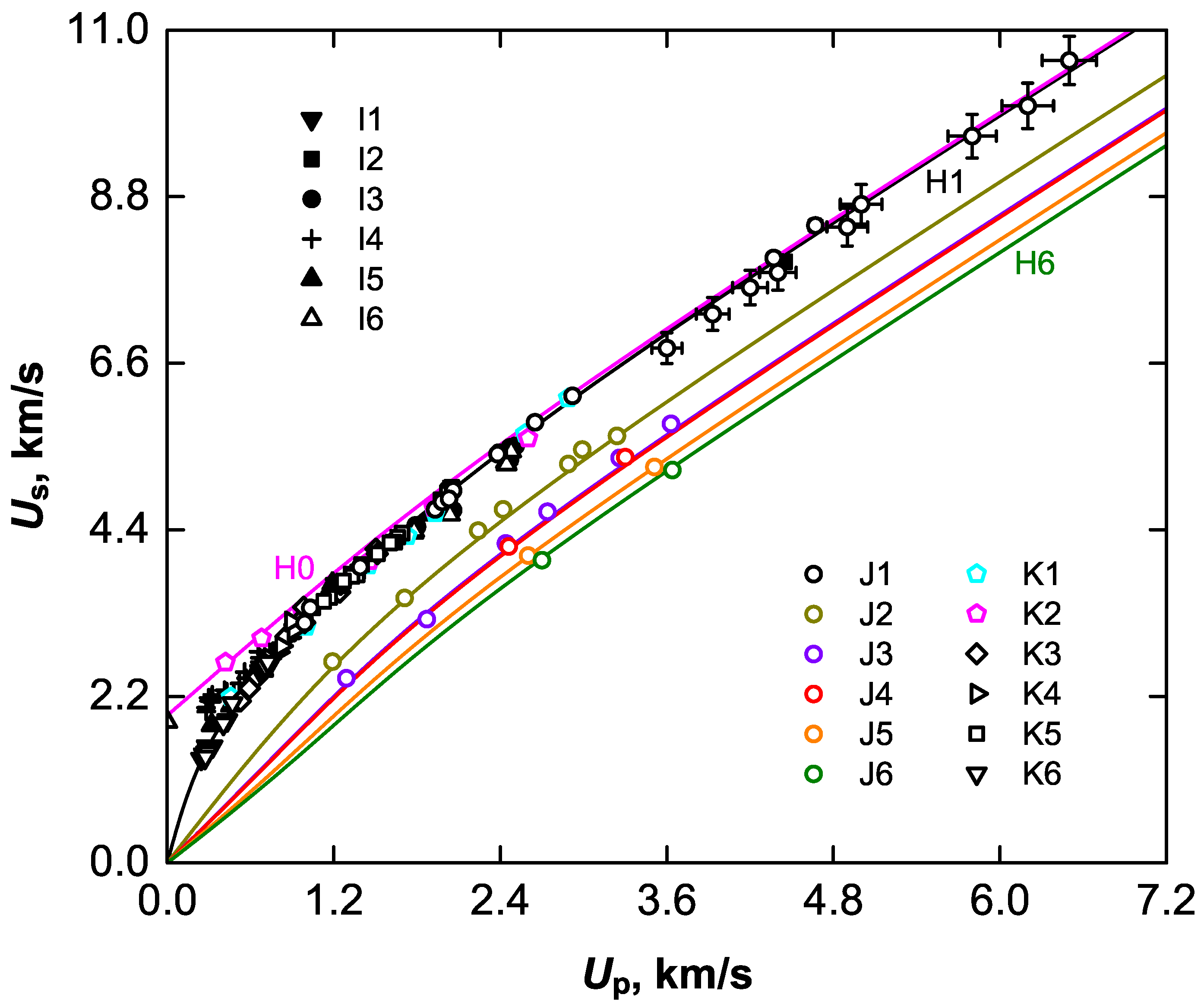
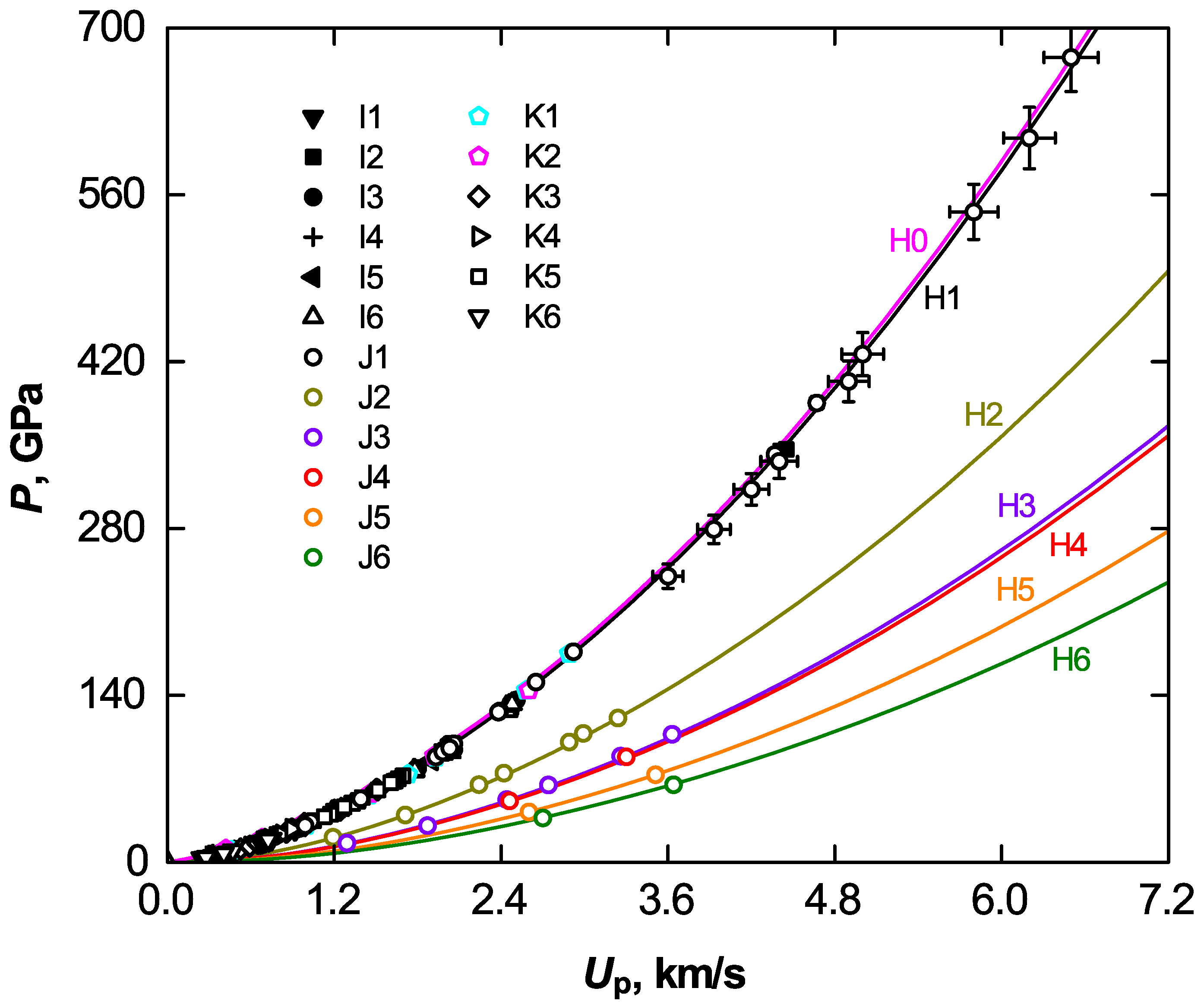
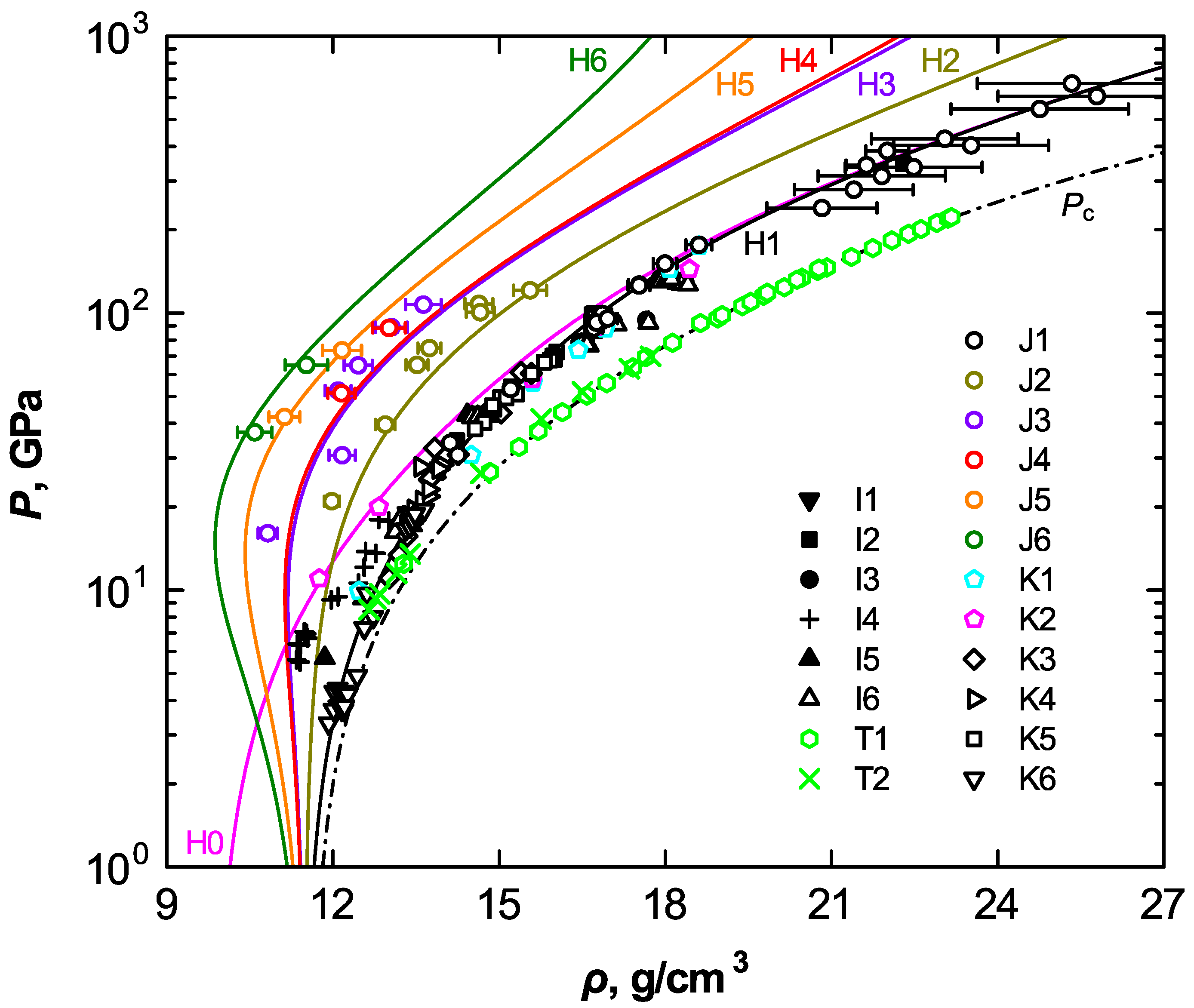
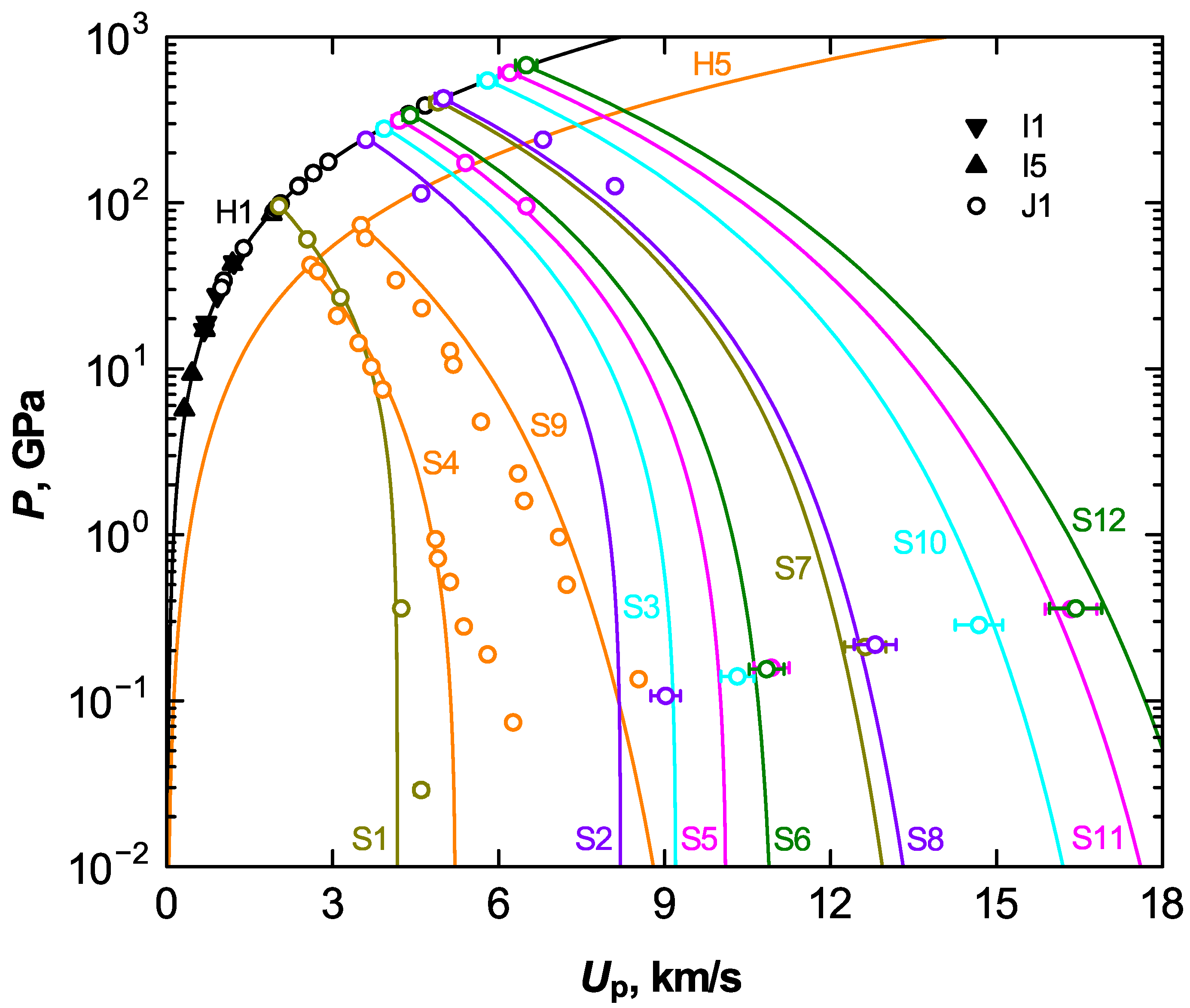
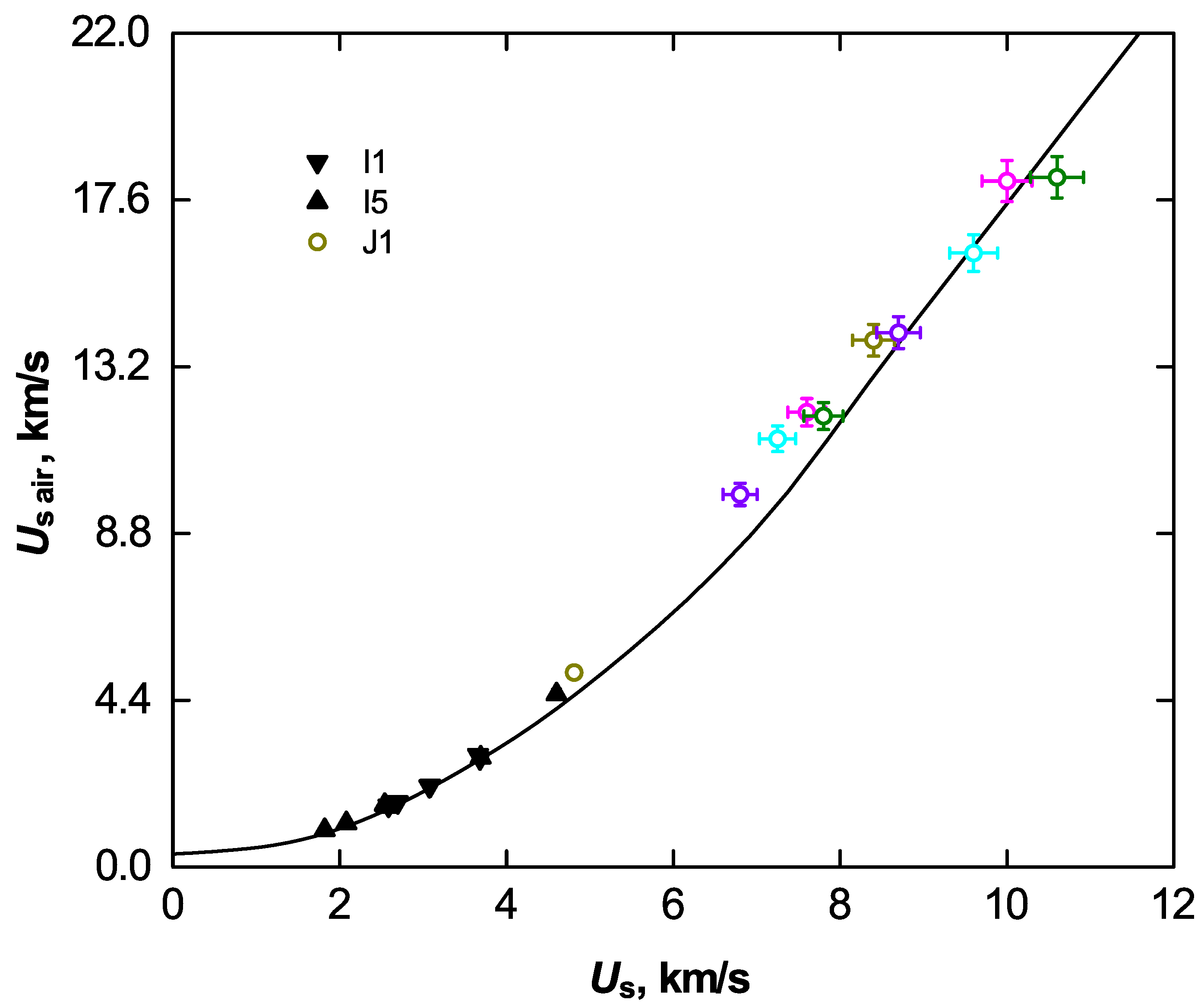
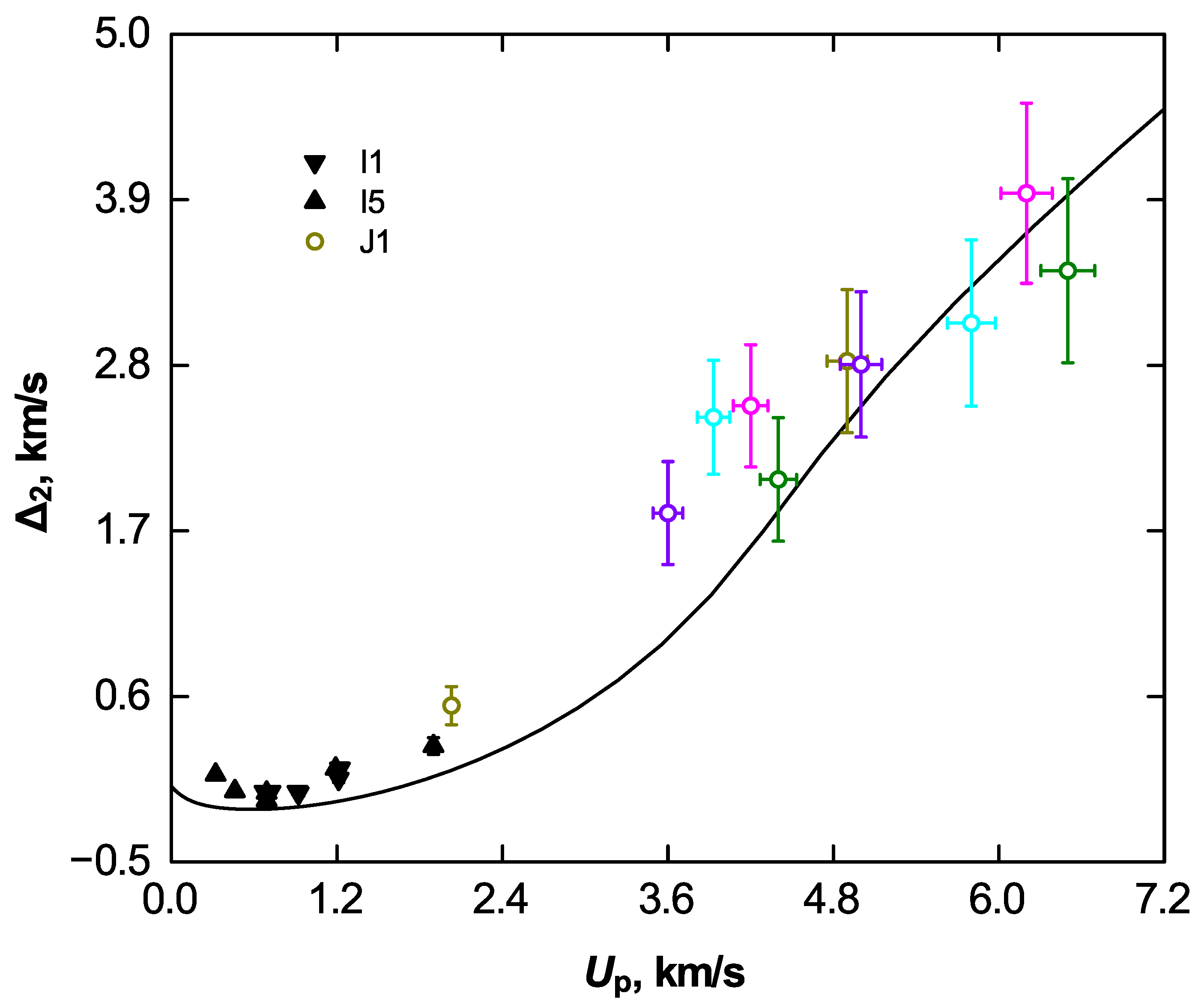
| , km/s | , km/s | P, GPa | , km/s | , km/s | , MPa | , km/s |
|---|---|---|---|---|---|---|
| 1 | 1 | 1 | ||||
| 1 | 1 | 1 | ||||
| 1 | 1 | 1 | ||||
| 1 | 1 | 1 | ||||
| 1 | 1 | 1 | ||||
| 1 | 1 | 1 | ||||
| 2 | 2 | 2 | ||||
| 2 | 2 | 2 | ||||
| 2 | 2 | 2 | ||||
| 2 | 2 | 2 | ||||
| 2 | 2 | 2 | ||||
| 2 | 2 | 2 | ||||
| 3 | 3 | 3 | ||||
| 3 | 3 | 3 | ||||
| 3 | 3 | 3 | ||||
| 3 | 3 | 3 | ||||
| 3 | 3 | 3 | ||||
| 3 | 3 | 3 | ||||
| 3 | 3 | 3 | ||||
| 3 | 3 | 3 | ||||
| 3 | 3 | 3 | ||||
| 3 | 3 | 3 |
Publisher’s Note: MDPI stays neutral with regard to jurisdictional claims in published maps and institutional affiliations. |
© 2022 by the author. Licensee MDPI, Basel, Switzerland. This article is an open access article distributed under the terms and conditions of the Creative Commons Attribution (CC BY) license (https://creativecommons.org/licenses/by/4.0/).
Share and Cite
Khishchenko, K.V. Equation of State for Bismuth at High Energy Densities. Energies 2022, 15, 7067. https://doi.org/10.3390/en15197067
Khishchenko KV. Equation of State for Bismuth at High Energy Densities. Energies. 2022; 15(19):7067. https://doi.org/10.3390/en15197067
Chicago/Turabian StyleKhishchenko, Konstantin V. 2022. "Equation of State for Bismuth at High Energy Densities" Energies 15, no. 19: 7067. https://doi.org/10.3390/en15197067
APA StyleKhishchenko, K. V. (2022). Equation of State for Bismuth at High Energy Densities. Energies, 15(19), 7067. https://doi.org/10.3390/en15197067






